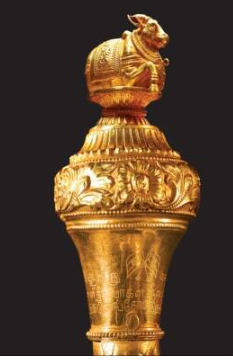ForumIAS announcing GS Foundation Program for UPSC CSE 2025-26 from 19 April. Click Here for more information.
ForumIAS Answer Writing Focus Group (AWFG) for Mains 2024 commencing from 24th June 2024. The Entrance Test for the program will be held on 28th April 2024 at 9 AM. To know more about the program visit: https://forumias.com/blog/awfg2024
Contents
Source: The post is based on the article “‘Sengol’ to be installed in the new parliament: Significance of the sceptre, first given to Nehru” published in the Indian Express on 25th May 2023
What is the News?
The Home Minister recently said that the upcoming inauguration of the new parliament building will also see Prime Minister installing a historic sceptre (Sengol) from Tamil Nadu next to the Lok Sabha Speaker’s seat.
What is Sengol?
It is derived from the Tamil word “Semmai”, meaning “Righteousness”. A ceremony was performed during the Chola dynasty, in which the transfer of power from one king to the other was sanctified and blessed by high priests. During this, the symbol (for the transfer of power) used was the handover of the ‘Sengol’ from one King to his successor.
The newly crowned ruler would be given the Sengol with an order to rule his subjects fairly and justly.
Why was the Sengol given to Nehru?
According to the official document, just before Independence, Lord Mountbatten, the last Viceroy of India, asked Nehru about “the ceremony that should be followed to symbolise the transfer of power from British to Indian hands”.
The soon-to-be prime minister went to consult C Rajagopalachari, the last Governor-General of India. He explained the details of Sengol and its associated ceremony.
How was the present Sengol made?

Once Nehru agreed to perform the suggested ceremony. Rajaji was tasked with the responsibility of arranging a sceptre.
Subsequently, he reached out to Thiruvaduthurai Atheenam, a well-known mutt in Tamil Nadu’s Tanjore district, for help and its leader commissioned the manufacturing of the Sengol to Chennai-based jewellers.
The present one was constructed by two men — Vummidi Ethirajulu and Vummidi Sudhakar. The sceptre measures five feet in length and has a ‘Nandi’ bull on top, symbolising justice.
How Sengol ceremony took shape during independence?
The sceptre is a “significant historical” symbol of Independence as it signifies the transfer of power from the British to the Indians. Pandit Jawahar Lal Nehru accepted Sengol on August 14, 1947, through the Adhinam of Tamil Nadu. It was a sign of the shift of power from the Britishers to the people of our country.
A song was played during the ceremony. It was composed by the 7th-century Tamil saint Tirugnana Sambandar — a child prodigy who lived only 16 years.




